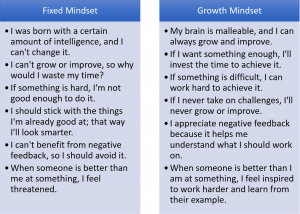Note: This is part 1 of a 4-part series on overcoming common barriers to learning. Tune in every Thursday for more insight from our Manager of Instruction, Jodie Westerman.
One of the biggest challenges students must face is disappointment. Whether it’s an exam that went poorly, a sports game that flopped, or an academic concept the student doesn’t understand right away, disappointment happens to everyone. It’s how we handle these setbacks, however, that determines whether we succeed or fail.
Today we’ll look at some common ways test prep students experience disappointment and how our tutors use proven pedagogical theory to position these students for success.
What disappointments will test prep students experience?
The typical test prep student begins a program with a diagnostic exam. This exam tells the student what her approximate score would be without any preparation or study. For many students, a low “starting score” can be a major disappointment. After all, no one likes falling short of their goals—especially on something as important and stressful as a standardized exam. Others will experience disappointments in different ways: an academic topic that doesn’t quite make sense, a score that temporarily stagnates, or even a bad test day. However, the setbacks a student experiences throughout a test prep program are much less important than the mindset she takes toward her own ability to improve.
What is growth mindset?
Psychologists distinguish between two attitudes students can take toward their own ability to improve: fixed mindset and growth mindset. If a student has a fixed mindset, she’ll believe her talents and abilities are unchangeable—that she’s good at what she’s good at and bad at what she’s bad at. If she embraces a growth mindset, however, she’ll understand that abilities can be developed and improved through hard work, dedication, and discipline.
As a tutor, I can tell right away whether my student holds a fixed or growth mindset. Fixed mindset students often express shame toward a lower starting score or may avoid the topic altogether, whereas growth mindset students openly discuss their struggles and are eager to create a game plan. Moreover, fixed mindset students generally refer to their weaknesses as permanent features, while growth mindset students see them as opportunities to get stronger. Here are just a few things both types of students might say or believe:

Both of these students can improve through hard work and effort. But only one of the students believes he can improve. As a result, only the growth mindset student invests time and effort in his studying, and only the growth mindset student improves. It’s a self-fulfilling prophesy!
How do ArborBridge tutors encourage a growth mindset?
Clearly, students should adopt a growth mindset if they want to succeed. But how do we convince students to change mindsets? ArborBridge tutors follow three basic tenants to empower, inspire, and motivate our students:
1) Set small, attainable goals.
Students with fixed mindsets are more likely than growth-minded students to expect instant results. When those expectations are not met, fixed mindset students conclude that they are not capable of reaching their goals and quickly give up. By setting small, attainable benchmarks throughout a program, tutors make it easier for students to see the fruits of their labor.
For example, I had a student—we’ll call her Katie—who began her ACT program with a starting score of 20 and a goal score of 31. While not impossible, this score increase would require a lot of time and effort, and Katie looked like she was already ready to throw in the towel. To show Katie she could improve, I set a very specific, attainable goal: a 4-point increase in English for her first program benchmark. While Katie was surprised by my reasonable request—“Don’t you want to see all my scores go up?” she asked—she was also motivated to reach this reasonable goal. When Katie met her first benchmark, she not only made progress toward her ultimate score goal, she also proved to herself that her hard work could pay off.
2) Connect effort with results.
Whenever I begin a new program with a student, one of the first things I discuss is homework. Research shows that concept mastery happens not through lectures or demonstrations but through purposeful repetition and practice. If a student wants to improve, she needs to match every hour she spends with me with at least one hour of related homework.
Sometimes students with a fixed mindset resist this idea. One student in particular comes to mind—we’ll call him Nathan. Nathan came to ArborBridge after a series of unsuccessful attempts to self-study for the SAT. When asked what methods Nathan had used to study, Nathan said he “took lots of practice tests.” “But what did you do differently after each practice test to improve your score?” I asked. “Well, nothing really. I just tried to do better.” In Nathan’s case, he was trying the same thing again and again and expecting a different result.
At ArborBridge, we connect every effort with the desired result. Students learn specific skills that address relevant test questions, and they master those skills through repetition and practice. By connecting effort with results, we help students regain control over the learning process and love learning all over again!
3) Meet each student at her level.
One of the easiest ways to lose a student’s interest is by presenting her with material that is either too easy or too hard. Material that is too easy can bore a student, while material that is too hard can create the false belief that the student is not capable of effectively learning new material.
For fixed-minded students, this is especially true. Because these students are more likely to seek out material that makes them feel good about themselves, fixed minded students may actively resist difficult new material. To ensure my student is properly challenged, I select lessons that are just out of reach. For example, if my ACT Math student mastered both the area and circumference of a circle, I might present her with practice problems that test these concepts in an unfamiliar or challenging context. Even though the student will struggle, she’ll also have the foundational skills to address the challenge in a constructive and rewarding way.
What does this mean for students?
While a growth mindset might seem overly simple (aren’t we all told to work hard toward the things we want?), it can be quite counterintuitive. Many students are told from a very young age that they are “good” only when they do something successfully and that they are “weak” or “failing” when they don’t. By praising results, not effort, teachers and authority figures encourage students to stay in their “safe zones” where they cannot grow or get better.
To break out of the safe zone and position students for success, I recommend praising effort, not just results. By focusing on the direct relationship between hard work and success, students will begin to understand that they are not stuck with a certain set of abilities. They can change or grow at any time—they just have to choose to do so!






